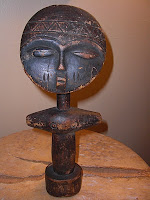Welcome to the (African) Dollhouse

In "the olden days," in Sub-Saharan Africa, there was a larger variety of dolls than nowadays, of which I'll describe a few. They used to be made of natural materials, such as wood, earth, or even weeds. Ashanti doll The Ashanti doll, from Ghana , is one of the most famous worldwide: a wood circle-face on a stick-like body (photo shown to the left) Moundang doll The Mandara mountains Moundang doll, from Northern Cameroon , made of volcanic rock, and decorated with tiny beads. This is the one which arguably least resembles the traditional European-style doll (photo right). Fali dolls from northern Cameroon : * male doll made of a corncob, decorated with cowry shells, European beads, leather strips, with a cotton skirt; * "boy" doll made of wood, with cowry shells, bells, leather strips (illustrations shown below); The Fali-Namchi dolls have been revisited in recent years, as shown below ...
